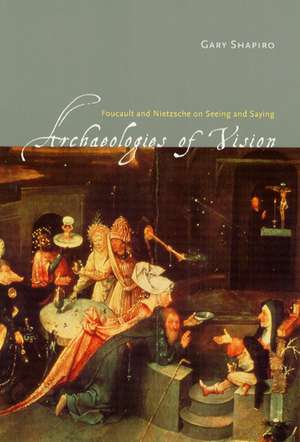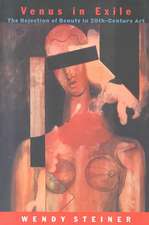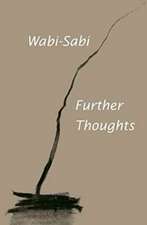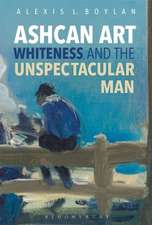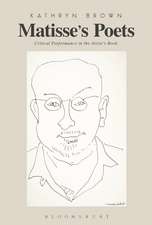Archaeologies of Vision: Foucault and Nietzsche on Seeing and Saying
Autor Gary Shapiroen Limba Engleză Paperback – 21 oct 2003
While many acknowledge that Friedrich Nietzsche and Michel Foucault have redefined our notions of time and history, few recognize the crucial role that "the infinite relation" between seeing and saying (as Foucault put it) plays in their work. Gary Shapiro reveals, for the first time, the full extent of Nietzsche and Foucault's concern with the visual.
Shapiro explores the whole range of Foucault's writings on visual art, including the theory of visual resistance, the concept of the phantasm or simulacrum, and his interrogation of the relation of painting, language, and power in artists from Bosch to Warhol. Shapiro also shows through an excavation of little-known writings that the visual is a major theme in Nietzsche's thought. In addition to explaining the significance of Nietzsche's analysis of Raphael, Dürer, and Claude Lorrain, he examines the philosopher's understanding of the visual dimension of Greek theater and Wagnerian opera and offers a powerful new reading of Thus Spoke Zarathustra.
Archaeologies of Vision will be a landmark work for all scholars of visual culture as well as for those engaged with continental philosophy.
Shapiro explores the whole range of Foucault's writings on visual art, including the theory of visual resistance, the concept of the phantasm or simulacrum, and his interrogation of the relation of painting, language, and power in artists from Bosch to Warhol. Shapiro also shows through an excavation of little-known writings that the visual is a major theme in Nietzsche's thought. In addition to explaining the significance of Nietzsche's analysis of Raphael, Dürer, and Claude Lorrain, he examines the philosopher's understanding of the visual dimension of Greek theater and Wagnerian opera and offers a powerful new reading of Thus Spoke Zarathustra.
Archaeologies of Vision will be a landmark work for all scholars of visual culture as well as for those engaged with continental philosophy.
Preț: 355.49 lei
Nou
Puncte Express: 533
Preț estimativ în valută:
68.02€ • 71.17$ • 56.51£
68.02€ • 71.17$ • 56.51£
Carte tipărită la comandă
Livrare economică 02-16 aprilie
Preluare comenzi: 021 569.72.76
Specificații
ISBN-13: 9780226750477
ISBN-10: 0226750477
Pagini: 458
Ilustrații: 34 halftones
Dimensiuni: 152 x 229 x 30 mm
Greutate: 0.6 kg
Ediția:1
Editura: University of Chicago Press
Colecția University of Chicago Press
ISBN-10: 0226750477
Pagini: 458
Ilustrații: 34 halftones
Dimensiuni: 152 x 229 x 30 mm
Greutate: 0.6 kg
Ediția:1
Editura: University of Chicago Press
Colecția University of Chicago Press
Notă biografică
Gary Shapiro is a professor of philosophy and Tucker-Boatwright Professor in the Humanities at the University of Richmond. He is the author of three previous books, including Alcyone: Nietzsche on Gifts, Noise and Women and Earthwards: Robert Smithson and Art after Babel.
Cuprins
List of Illustrations
Preface
References and Abbreviations
Introduction: The Abyss of Vision
1. Iconoclasm and Indoctrination: The Taliban and the Teletubbies
2. Denigrating or Analyzing Vision?
3. Foucault as Illustrator: The Case of Frans Hals
4. Nietzsche's Story of the Eye
5. Realism: Reading from Left to Right
6. Hidden Images: Before the Age of Art
7. Nietzsche and Heidegger on Visual History
One - Between Sun and Cyclops: Nietzsche at the Dresden Gallery
8. Eye Trouble
9. Glances of the Golden Age
10. Deconstructing the Video
11. "Claude Lorraine-like Raptures and Tears"
12. Nietzsche and the Time of the Museum
13. A Tour of the Dresden Gallery
Two - Nietzsche's Laocoön: Crossings of Painting and Poetry
14. Aesthetics: Nietzsche contra Lessing
15. Modernism and Its Discontents: Nietzsche after Greenberg
16. Images, Words, and Music
17. The Silence of Saint Cecilia
18. The Birth of The Birth of Tragedy
Three - "This is Not a Christ": Art in The Birth of Tragedy
19. Transfiguring the Transfiguration
20. Floating and Shining
21. Double-Coding the Sistine Madonna
22. The Death of (Metaphysical) Art
23. The Knight, Death, and the Devil
24. Nietzsche and the Little Black Dress: All the Costumes of History
Four - übersehen: Architecture and Excess in the Theater of Dionysus
25. Optical Illusions
26. Aesthetics of Presence
27. Double Vision: Seeing like an Athenian
28. The Theatrical Dispoitif
29. Perspectivism and Cyclops Vision
30. Postclassical Framing
31. Nietzsche in Bayreuth
Five - In the Twinkling of an Eye: Zarathustra on the Gaze and the Glance
32. The Optics of Value
33. The Question of the Augenblick
34. The Evil Eye and Its Radiant Other
35. Zarathustra's Interpretation of Dreams
36. Vertigo
37. The Nausea of Vision
38. Recurrence as Medusa's Head
39. High Noon: Hyphenating the Augen-Blick
Six - Foucault's Story of the Eye: Madness, Dreams, Literature
40. Painting and Pleasure: What Do Philosophers Dream Of?
41. The Difficulty of Silence
42. Bataille's Deconstruction of the Eye
43. Return of the Phantasm: Dream Vision
44. Temptations: Bosch and Other Visionaries
45. Fantasia of the Library: The Birth of Literature out of the Spirit of Painting
Seven - Critique of Impure Phenomenology
46. Merleau-Ponty's Evasion of Nietzsche: Misreading Malraux
47. Cézanne or Velazquez: What Is an Artist?
48. The Painter as Phenomenologist
49. The Visible and the Invisible
50. The Mirror of the Sovereign
51. "Enslaved Sovereign, Observed Spectator"
Eight - Seeing and Saying: Foucault's Ekphrasis of Las Meninas
52. What's in a Name?
53. Ekphrasis
54. Construction of the "We"
55. The Vanishing Subject of Vision
Nine - Toward an Archaeology of Painting
56. Archaeology and Genealogy of the Visible
57. From Renaissance Similitude to Postmodern Simulacrum
58. Klee, Kardinsy, Magritte
59. Archaeology without the Episteme?
Ten - Visual Regimes and Visual Resistance: From the Panopticon to Manet's Bar
60. Nietzsche and the Theater of Cruelty
61. Foucault's Scenarios
62. Bentham and Plato as Philosopher-Architects
63. Panopticon
64. The Visual State
65. Shutters and Mirrors: Manet Closes the Panopicon Window
66. Wanderers and Shadows
67. The Prison of the Gallery and the Force of Flight
Eleven - Pipe Dreams: Recurrence of the Simulacrum in Klossowski, Deleuze, and Magritte
68. Simulacra, or Floating Images
69. Diana at Her Bath: Theophany as Vision and Text
70. Vicious Circles
71. Déjà Vu: Recurrence of the Image, Once More
72. Epistemology at the Blackboard
73. Resemblance and Similitude
Twelve - The Phantasm in the Age of Mechanical Reproduction
74. Warhol and His Doubles: One Brillo Box or Many?
75. Hegelian Themes: On the Comedy of Art and Its Death
76. Stupidity and the "Eternal Phantasm"
77. Pop without a Patriarch: Deleuze, Difference, and Warhol
78. Photogenic Painting: The Frenzy of the Circulating Image
79. What Do Photographers Dream of? Duane Michals and the Uses of Pleasure
80. Retrospective
Notes
Index
Preface
References and Abbreviations
Introduction: The Abyss of Vision
1. Iconoclasm and Indoctrination: The Taliban and the Teletubbies
2. Denigrating or Analyzing Vision?
3. Foucault as Illustrator: The Case of Frans Hals
4. Nietzsche's Story of the Eye
5. Realism: Reading from Left to Right
6. Hidden Images: Before the Age of Art
7. Nietzsche and Heidegger on Visual History
One - Between Sun and Cyclops: Nietzsche at the Dresden Gallery
8. Eye Trouble
9. Glances of the Golden Age
10. Deconstructing the Video
11. "Claude Lorraine-like Raptures and Tears"
12. Nietzsche and the Time of the Museum
13. A Tour of the Dresden Gallery
Two - Nietzsche's Laocoön: Crossings of Painting and Poetry
14. Aesthetics: Nietzsche contra Lessing
15. Modernism and Its Discontents: Nietzsche after Greenberg
16. Images, Words, and Music
17. The Silence of Saint Cecilia
18. The Birth of The Birth of Tragedy
Three - "This is Not a Christ": Art in The Birth of Tragedy
19. Transfiguring the Transfiguration
20. Floating and Shining
21. Double-Coding the Sistine Madonna
22. The Death of (Metaphysical) Art
23. The Knight, Death, and the Devil
24. Nietzsche and the Little Black Dress: All the Costumes of History
Four - übersehen: Architecture and Excess in the Theater of Dionysus
25. Optical Illusions
26. Aesthetics of Presence
27. Double Vision: Seeing like an Athenian
28. The Theatrical Dispoitif
29. Perspectivism and Cyclops Vision
30. Postclassical Framing
31. Nietzsche in Bayreuth
Five - In the Twinkling of an Eye: Zarathustra on the Gaze and the Glance
32. The Optics of Value
33. The Question of the Augenblick
34. The Evil Eye and Its Radiant Other
35. Zarathustra's Interpretation of Dreams
36. Vertigo
37. The Nausea of Vision
38. Recurrence as Medusa's Head
39. High Noon: Hyphenating the Augen-Blick
Six - Foucault's Story of the Eye: Madness, Dreams, Literature
40. Painting and Pleasure: What Do Philosophers Dream Of?
41. The Difficulty of Silence
42. Bataille's Deconstruction of the Eye
43. Return of the Phantasm: Dream Vision
44. Temptations: Bosch and Other Visionaries
45. Fantasia of the Library: The Birth of Literature out of the Spirit of Painting
Seven - Critique of Impure Phenomenology
46. Merleau-Ponty's Evasion of Nietzsche: Misreading Malraux
47. Cézanne or Velazquez: What Is an Artist?
48. The Painter as Phenomenologist
49. The Visible and the Invisible
50. The Mirror of the Sovereign
51. "Enslaved Sovereign, Observed Spectator"
Eight - Seeing and Saying: Foucault's Ekphrasis of Las Meninas
52. What's in a Name?
53. Ekphrasis
54. Construction of the "We"
55. The Vanishing Subject of Vision
Nine - Toward an Archaeology of Painting
56. Archaeology and Genealogy of the Visible
57. From Renaissance Similitude to Postmodern Simulacrum
58. Klee, Kardinsy, Magritte
59. Archaeology without the Episteme?
Ten - Visual Regimes and Visual Resistance: From the Panopticon to Manet's Bar
60. Nietzsche and the Theater of Cruelty
61. Foucault's Scenarios
62. Bentham and Plato as Philosopher-Architects
63. Panopticon
64. The Visual State
65. Shutters and Mirrors: Manet Closes the Panopicon Window
66. Wanderers and Shadows
67. The Prison of the Gallery and the Force of Flight
Eleven - Pipe Dreams: Recurrence of the Simulacrum in Klossowski, Deleuze, and Magritte
68. Simulacra, or Floating Images
69. Diana at Her Bath: Theophany as Vision and Text
70. Vicious Circles
71. Déjà Vu: Recurrence of the Image, Once More
72. Epistemology at the Blackboard
73. Resemblance and Similitude
Twelve - The Phantasm in the Age of Mechanical Reproduction
74. Warhol and His Doubles: One Brillo Box or Many?
75. Hegelian Themes: On the Comedy of Art and Its Death
76. Stupidity and the "Eternal Phantasm"
77. Pop without a Patriarch: Deleuze, Difference, and Warhol
78. Photogenic Painting: The Frenzy of the Circulating Image
79. What Do Photographers Dream of? Duane Michals and the Uses of Pleasure
80. Retrospective
Notes
Index
